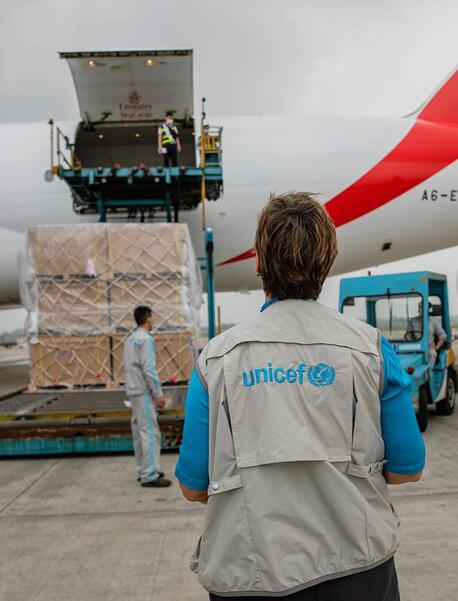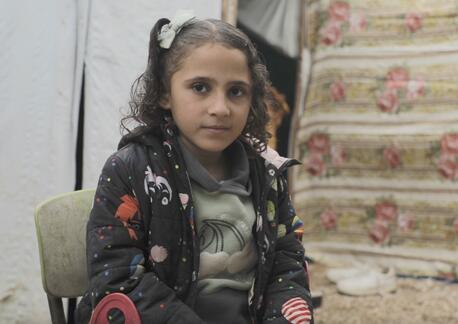
Protect Children in Conflict: UNICEF's Call to Action for 2025
As conflicts rage on in so many parts of the world, the suffering may seem insurmountable. But UNICEF is reaching millions of children caught in these crises every day with health care, nutrition, protection, education and other life-sustaining support. Looking to the year ahead, UNICEF is urging the international community to do more to end rights violations and protect children's futures. Donor support is crucial.
More than 473 million of the world's children caught in conflict
The impact of armed conflicts on children around the world reached devastating and likely record levels in 2024, according to a UNICEF review of the latest available data and prevailing global trends.
Close to 19 percent of the world’s children are now living in conflict zones — up from around 10 percent in the 1990s, UNICEF reported. That amounts to over 473 million children — nearly 1 in 5 globally — as the world experiences the highest number of conflicts since World War II.
According to UNICEF, 2024 is likely to break the record for most ever United Nations-verified grave violations against children. In 2023, there were 32,990 grave violations against 22,557 children verified by the UN, the highest number since Security Council-mandated monitoring began two decades ago. Violations include killings, maimings, abductions and recruitment into armed groups.
As conflicts intensified in places like Gaza and Lebanon, Myanmar, Syria and elsewhere in 2024, the number of children displaced by conflict and violence is also expected to keep rising beyond the 2023 year-end total of 47.2 million.
“This must not be the new normal," UNICEF Executive Director Catherine Russell said. "We cannot allow a generation of children to become collateral damage to the world’s unchecked wars.”
This must not be the new normal. We cannot allow a generation of children to become collateral damage to the world’s unchecked wars. — UNICEF Executive Director Catherine Russell
Conflict drives approximately 80 percent of all humanitarian needs, disrupting access to safe water, food, health care and other essentials. In countries affected by conflict, on average over a third of the population are poor (34.8 percent) compared to just over 10 percent in non-conflict-affected countries.
Children in conflict are far more likely to be killed or injured, critically malnourished and out of school. The impact on children's mental health is also huge.
"The world is failing these children," Russell said. "As we look towards 2025, we must do more to turn the tide and save and improve the lives of children."
In conflict, risks to women and girls, children with disabilities particularly high
Children account for 30 percent of the global population, yet they account for roughly 40 percent of refugee populations and 49 percent of internally displaced people, on average.
The situation for women and girls is particularly concerning, with widespread reports of rape and sexual violence in conflict settings. In Haiti so far this year, reported incidents of sexual violence against children have increased tenfold.
In situations of armed conflict, children with disabilities also tend to be disproportionately exposed to violence and rights violations.
UNICEF continues to call for all parties to conflict, and for those with influence over them, to take decisive action to end the suffering of children, to ensure their rights are upheld and to adhere to their obligations under international humanitarian law.

Advocating for the safeguarding of children's rights, meeting emergency needs of children in conflict
In its role as global advocate for children's rights — as set forth under the 1989 Convention on the Rights of the Child — UNICEF offers a change agenda that urges warring parties, those with influence over them and humanitarian actors worldwide to do what is necessary to end grave violations against children; to hold perpetrators of child rights violations to account; and to work toward inclusive and lasting peace.
At the same time, UNICEF emergency response teams remain active in humanitarian settings worldwide — including in areas of armed conflict — delivering lifesaving and life-sustaining assistance to impacted children and families.
When violence erupts, UNICEF staff, together with partners, mobilize to provide safe water, nutrition supplements, vaccines, hygiene kits and other emergency supplies. At the onset of a crisis, UNICEF also deploys extra personnel to help keep children connected to critical health care, education and psychosocial support.
The humanitarian imperative is to reach children in need, regardless of the circumstances they were been born into, help keep essential services going and to support sustainable recovery.
With humanitarian needs mounting, donor support in the form of flexible funding is a critical as ever.
UNICEF's Humanitarian Action for Children appeal for 2025 spells out how flexible funding enables UNICEF to respond quickly and adapt that response as situations evolve.
Help UNICEF reach more children in need. Donate today.
HOW TO HELP
There are many ways to make a difference
War, famine, poverty, natural disasters — threats to the world's children keep coming. But UNICEF won't stop working to keep children healthy and safe.
UNICEF works in over 190 countries and territories — more places than any other children's organization. UNICEF has the world's largest humanitarian warehouse and, when disaster strikes, can get supplies almost anywhere within 72 hours. Constantly innovating, always advocating for a better world for children, UNICEF works to ensure that every child can grow up healthy, educated, protected and respected.
Would you like to help give all children the opportunity to reach their full potential? There are many ways to get involved.





